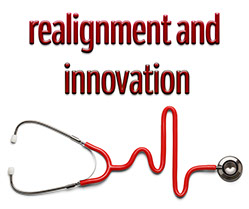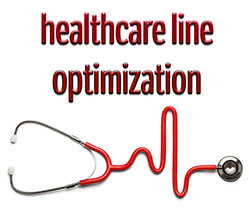SERVICE
LINES /
PROJECTS
HEALTHCARE



Click
above to review these service lines in more detail.
RETAIL / OTHER
OVERVIEW
STRATEGIC REALIGNMENT AND INNOVATION
HEALTHCARE LINE OPTIMIZATION


PRIMARY CARE RE-DESIGN
PREDICTIVE ANALYTICS
VIDEO
CENTER
CONSULTING
PLATFORMS
SOFTWARE
SOLUTIONS BY INDUSTRY
Back to Top
OVERVIEW:
The challenges faced by healthcare systems are all too well understood. Decreased payer diversity. The rise of ACO's. Increased litigation. Entry of non-traditional/lower cost providers. The exodus of high profitability specialty medicine. An uncertain and shifting regulatory environment. And that's just for starters! These challenges make risk mitigation-based decision support (RMBDS) mission critical. Since 1998 DSS has developed and delivered three distinct RMBDS service lines for healthcare and partnered on a fourth:
1. System Realignment and Innovation: transformation that leads to new revenue.
2. Healthcare Line Optimization: meeting consumer expectations at LOWER cost
3. Digital Health/Predictive Analytics: proactive medicine without the hype or cost.
4. Internal Transformation: change that increases efficiency, lowers cost, and creates a culture of continuous improvement.
Click the small squares on the upper right to review our RMBDS service lines.
Back to Top
SERVICE LINE:
EXAMPLE CLIENT:
System Realignment & Innovation Practice (SRI)
2004-Now
ThedaCare, a four hospital system in Wisconsin
SUMMARY
OBJECTIVES
RESULTS
DSE TECHNOLOGIES USED
DIFFERENTIATION
Strategic Realignment and Innovation: (SRI) SRI asks long overdue questions about a hospital system's existing delivery model. First, does it still align to our mission? Does it lower costs? Does it optimally drive both quality and profitability? Are all of our systems/processes necessary? What is their ROI? Last, what innovative or re-engineered practices will achieve these outcomes?
To address these questions we have developed our Strategic Realignment and Innovation (SRI) practice. While SRI's assessment scorecard covers over 100 factors, historically, the four largest SRI "winners" for hospital systems are: 1) EMR deployment/management 2) specialty medicine optimization 3) back-office re-engineering to reduce provider costs and 4) phasing in lower cost (mid-tier) health providers and healthcare navigators.
- Does our delivery model still align to our mission?
- Does it lower costs?
- Does it optimally drive both quality and profitability?
- Which aspects of our delivery model are necessary?
- What is their ROI?
- What new innovations will answer the same five questions above?
- What mix of system change and innovation should we adopt?
- In what order (priority)?
- What is the 12/24/36/60 month P/L of implementing those changes?
Our SRI engagements have discovered in no particular order:
- EMR's are doubtless necessary...but they must be open. Do not purchase an EMR system where the provider somehow thinks they own your data (2004).
- Up to 75% of the primary care visit load can be handled by lower cost mid-tier providers (PA's, NP's, RN's) but this varies by consumer segment (e.g. by relationship, speed, service), by type of visit (acute/chronic) and by pediatric vs. adult medicine.
- Consumers will easily accept a centralized call center. Configuration of that call center is critical so that it adds value and is not merely a cost-saving device.
- An NPV (Net Par Value) market simulators best solve for the service level changes that will maximize value to the customer at the minimum cost to implement.
- Adaptive Pairwise Trade-off Surveying: reproduces the real-world trade-offs and learns from prior answers to customize the survey to each consumer.
- Advanced Algorithms Find What Is Truly Important: Advanced mathematics make possible a simulator that makes the same choices as the consumer.
- SegmentSolveTM: identifies the optimal market segments using 13 algorithms.
- ProductSolve / NPVTM: a goal-solving market simulator equipped with salary and cost data. By capturing buyer values (what's important to the consumer), and knowing the cost-to-implement, cost-to-transition, and cost-to-serve, the NPV simulator solves for the optimum provider and service mix at the lowest overall cost.
- PositionSolveTM: visualizes the positioning of each hospital system to discover how to move into innovative but currently unpopulated areas of demand.
- Gets Down to the Bedrock - the Real "Key Drivers": via adaptive pairwise trade-off which whittles down the factors (attributes) that really move the needle.
- Industry-Leading Accuracy in Quantifying Those Key Drivers : via a proprietary, convergent, utility calculation process.
- Produces Strategies That Maximize Bang for the Buck: via our goal-solving simulator.
- You Get the Fishing Pole, Not Just the Fish: By capturing what's important to the consumer in the simulator - we no longer need to create endless surveys. This allows the simulator to discover which products consumers will buy/retain, etc.
- Generates the Most THOROUGH Recommendations.: Because our goal-solving simulator tests hundreds of millions of strategies to discover those that meet YOUR criteria (e.g. the feature changes that maximize revenue at lowest cost).
Back to Top
SERVICE LINE:
EXAMPLE CLIENT:
Healthcare Line Optimization
1998-Present
Seven Engagements for a Mid-Size Hospital System
SUMMARY
OBJECTIVES
RESULTS
DSE TECHNOLOGIES USED
DIFFERENTIATION
System transformation must be more than internal and process-focused. It must also be customer/patient facing. This may seem counterintuitive since most traditional consumer initiatives increase costs. This is where Healthcare Line Optimization (HCLO) comes in.
HCLO redesigns healthcare service lines (e.g. primary care, orthopedics, cardiology, neurology) so that they maximally meet consumer preferences while lowering the cost to implement via advanced goal-solving and cost-informed simulators. These simulators have been successfully deployed in dozens of engagements for over a dozen Fortune 500 companies. HCLO is especially critical for increasing profitability for the system as a whole - and not the specialty practice alone.
- Re-engineer primary care, cardiology, neurology, oncology and orthopedics healthcare lines to better meet patient preferences while lowering cost-to-serve and maintain.
-
For each healthcare line:
- Identify "trade-offs" ...the drivers that are most important. Improve those and de-service the less important attributes. This lowers the overall cost-to-serve.
- Identify new delivery configurations that will increase preference for non-customers.
- Identify blunting strategies; strategies that blunt competitive encroachment.
- Identify optimal service configurations that will better retain existing patients.
- Identify the most distinctly different patient segments in each healthcare line and the best ways to deliver service to each segment at the lowest cost.
- Re-engineer the go-to-market strategy for each healthcare line.
-
Meeting the actual "buyer values" of patients grows healthcare quality an average of 10% on key NHCQ metrics, and saves delivery costs by an average of 5% per line.
- Identified "trade-offs" attributes, drivers we that are differentially more important. Improved those while de-servicing other saved 5-7% for each business line.
-
Tested over 200,000 new delivery configurations in the simulator and identified:
- New delivery configurations that will grab preference share for not-in-system patients. Implemented the best one for all lines.
- Optimal service configuration that will retain consumers.
- Competitive blunting strategies that grabbed share from new "encroachers".
- Identified the most distinctly different patient segments in each healthcare line and how best to deliver service to each segment at the lowest cost.
- Re-engineered the go-to-market strategy for each healthcare line.
- Main Segments: Cost, Speed, Personal Time/Relationship, Advanced Care
- Adaptive Pairwise Trade-off Surveying: reproduces the real-world trade-offs and learns from prior answers to customize the survey to each consumer.
- Advanced Algorithms Find What Is Truly Important: Hundreds of combinations algorithms, sub-algorithms, iterations, weighting of survey sections uncovers the "utilities" that result in the simulator making the same choices as the consumer.
- SegmentSolveTM: Uses 13 separate algorithms to converge upon the most highly separated consumer segments.
- ProductSolveTM: a goal-solving market simulator. By capturing values (what's important to the consumer) we no longer need to create endless surveys. Instead we create new products in the simulator (by what-iffing or goal solving) to discover which healthcare line changes consumers will prefer and which will minimize cost AND improve healthcare quality.
- PositionSolveTM :visualizes the positioning of each competing healthcare system and discover how to move into innovative but currently unpopulated areas of demand.
- Gets Down to the Bedrock - the Real "Key Drivers": adaptive pairwise trade-off whittles down the factors (attributes) that really move the needle for real-world outcomes.
- Industry-Leading Accuracy in Quantifying Those Key Drivers : uncovers the "utilities" that result in the simulator making the same choices as the consumer (via hundreds of discrete combinations of algorithms, iterations, weighting of survey sections, etc.)
- Produces Optimal Strategies That Maximize Profit: via goal-solving simulators.
- You Get the Fishing Pole Not the Fish: By capturing values (what's important) we no longer need to create endless surveys. Instead we create new products in the simulator to discover which products consumers will buy and which will maximize customer retention.
- Generates the Most THOROUGH Recommendations.: Because our goal-solving simulator tests hundreds of millions of strategies to discover the ones that meet YOUR criteria (e.g. the feature changes that maximize revenue at lowest cost to implement).
Back to Top
SERVICE LINE:
EXAMPLE CLIENT:
Primary Care Re-Design
A Leading Midwest Hospital System
1998-Present
SUMMARY
OBJECTIVES
RESULTS
DSE TECHNOLOGIES USED
DIFFERENTIATION
The entry portal to healthcare is still the primary care physician. Yet, primary care is increasingly being viewed as a "loss-leader" for the healthcare system. How can we re-engineer primary care to retain consumers AND drive down costs?
- Re-engineer primary care to better meet patient preferences while lowering cost-to-serve.
- Identify "trade-offs" attributes (drivers we that are differentially more important.) Improve those attributes and de-service others in order to lower the overall cost-to-serve.
- Identify a new delivery model that will increase preference share for both in-system and out-of-system patients.
- Identify blunting strategies; strategies that blunt competitive encroachment.
- Identify optimal service configuration that will better retain existing patients.
- Identify the most distinctly different patient segments and the best ways to deliver service to each segment at the lowest cost.
- Re-engineer the go-to-market strategy for primary care.
-
Meeting the actual "buyer values" of patients grows perceived healthcare quality (acquisition) by up to 15%, saves the delivery cost of primary care by 5%.
- Saved 5-7% for each business line. by identified differentially more important."trade-offs" attributes. Improved those while de-servicing others.
-
Tested over 200,000 new delivery configurations in the simulators and identified:
- New delivery configurations that improved preference share.
- Optimal service configuration that will retain consumers.
- Optimal blunting strategies that blunted "encroachment from competitors.
- Identified the most distinctly different patient segments and how best to deliver service to each segment at the lowest cost.
- Re-engineered the go-to-market strategy for primary care. Result: a new, more streamlined patient experience. Decreased waiting room time by 70% on average.
- Main Segments: Cost, Two Types of Speed, Personal Time/Relationship, Advanced Care
- Adaptive Pairwise Trade-off Surveying: reproduces the real-world trade-offs and learns from prior answers to customize the survey to each primary care consumer.
- Advanced Algorithms Find What Is Truly Important: Hundreds of combinations algorithms, sub-algorithms, iterations, weighting of survey sections uncovers the "utilities" that result in the simulator making the same choices as the consumer.
- SegmentSolveTM: Uses 13 separate algorithms to converge upon the most highly separated primary care segments.
- ProductSolveTM: a goal-solving market simulator. By capturing values (what's important to the primary care consumer) we no longer need to create endless surveys. Instead we create new products in the simulator (by what-iffing or goal solving) to discover which changes will minimize cost AND maximize primary care preference and quality.
- PositionSolveTM :visualizes the positioning of each competing primary care system and discover how to move into innovative but currently unpopulated areas of demand.
- Gets Down to the Bedrock - the Real "Key Drivers": adaptive pairwise trade-off whittles down the attributes that really move the needle for any of 12 real-world outcomes.
- Industry-Leading Accuracy in Quantifying Those Key Drivers : uncovers the most accurate "utilities." This allows the simulator to make the same choices as the primary care consumer. (via advanced algorithms,, weighting of survey sections, etc.)
- Produces the Optimal Bang for the Buck Strategies: via cost-informed goal-solving.
- You Get the Fishing Pole Not the Fish: By capturing values (what's important) we no longer need to create endless surveys. Instead we create new products in the simulator to discover which products consumers will buy and which will maximize retention.
- Generates the Most THOROUGH Recommendations.: Because our goal-solving simulator tests hundreds of millions of strategies to discover the ones that meet YOUR criteria (e.g. the feature changes that maximize revenue at lowest cost to implement).
Back to Top
SERVICE LINE:
Predictive Analytics / The ASCLEPIUS System
1995-Present
EXAMPLE CLIENT:
The Precursor to ASCLEPIUS Has Been Deployed at Four Fortune 500 Firms
SUMMARY
OBJECTIVES
RESULTS
DIFFERENTIATION
Hospital systems must implement digital health initiatives but often not the ones digital health consultants recommend! A business case demonstrates that the most potent digital health initiatives must include BI (business intelligence) and PA predictive analytics to: 1) provide early detection of preventable disease 2) minimize misdiagnoses and reduce the healthcare system's medical liability cross-section 3) improve healthcare delivery efficiency 4) improve system-wide quality metrics 5) and improve payment performance.
- Lower cost of traditional consulting Predictive Analytics by 90% and traditional EMR-based PA solutions by 80%.
-
Improve PA in Healthcare systems so as to:
- Continuously predict the most frequent 2000 CPT diagnostic codes.
- Continuously apply human rule-based insight (HRBI ) to predict those same CPT codes. This develops parallel predictive models alongside PA models.
- Arbitrate between PA and HRBI models to yields models that combine "the best of both worlds" (PA plus human insight).
- Combine RT acute care medical monitoring + historical data mining to issue alerts to acute care personnel of impending coding or "out-of-family" readings.
- Perform automated reporting across all visits to meet emerging NQF standards.
- Big Data Predictive Analytics to predict patient payment performance.
- The precursor system PA system to ASCLEPIUS (MiningSolve) has been deployed at four Fortune 500 companies and has identified hundreds of millions of dollars in actionable dollar opportunity recovery,.
- The ASCEPIUS system is currently in Phase I pilot.
- To become a zero cost pilot site for ASCLEPIUS, contact info@decisionsupportsciences.com or call 630 (428-1847).
- Continuously improves Predictive Analytics (PA) models to predict the most frequent 2000 CPT diagnostic codes.
- Continuously apply human rule-based insight (HRBI ) to predict those same CPT diagnostic codes. This provides predictive correspondence.
- Predict undiscovered disease in asymptomatic patients by arbitrating between PA and HRBI models to combine "the best of both worlds."
- Combine RT networked acute care medical monitoring + historical data mining to issue alerts to acute care personnel of impending coding.
- Perform automated reporting to meet emerging NQF standards.
- Big Data Predictive Analytics to predict patient payment performance.